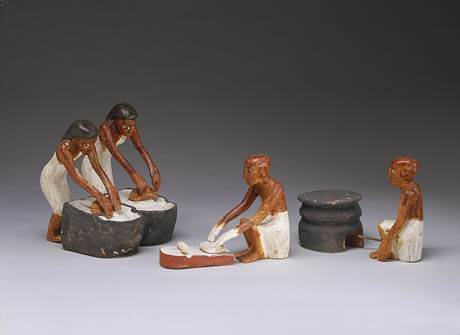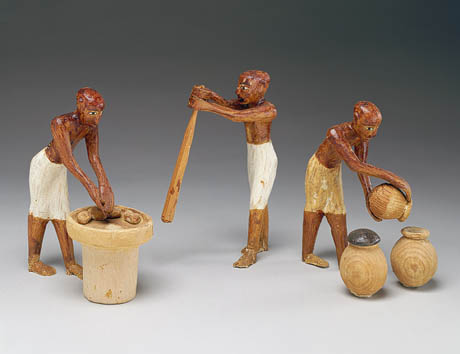


IMAGE: Model bakery from the tomb of Meketre, chancellor to Mentuhotep II and III. From the collection of the Metropolitan Museum of Art, New York (Egypt, ~1975 B.C., plastered and painted wood, height of tallest figure is 18cm).
This model, part of the ancient Egyptian funerary equipment of Meketre, chancellor to Metuhotep II and III, represents a combined bakery and brewery. Even though many of the figures are performing the same tasks, each is unique (as in Qin Shi Huang’s Terracotta Army or Antony Gormley’s Field).
According to Catharine Roehrig, Curator of Egyptian Art at the Metropolitan Museum of Art, bread and beer were “the staples of the Egyptian diet”and were typically “made from the same ingredients and […] produced in a bakery and brewery that were side by side.”
The baking of bread was a fairly straightforward process: the grain was pounded, ground into flour, formed into loaves, and baked. Brewing was a longer process requiring several extra steps.
The bakery supplied loaves of coarse barley flour that were only partially baked, so as not to kill the leavening agent. These loaves were broken up and mixed with water and crushed dates, which provided sugar to promote fermentation. When the resulting brew was ready, the thick liquid was strained through a sieve and decanted into jars that were sealed for later use.
As you can see in the architectural model, Meketre’s brewers and bakers worked side-by-side throughout the afterlife, in a single unit of grain-based production. By uniting the various possibilities of a plant under a single roof, Meketre’s model becomes a secular temple to both the generosity of grain and the alchemical powers of human ingenuity.
(On a similar note, check out Christien Meindertsma’s PIG 05049, which collects the various futures of a single pig between the covers of a single book.)